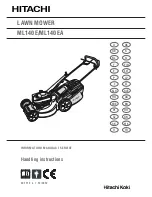
12
TM/MC
circuitry of the battery pack. Longest life and
best performance can be obtained if the
battery pack is charged in the normal room
condition.
10. Disconnect charger from the power supply
when not in use. This will reduce the risk of
electric shock or damage to the charger if
metal items should fall into the opening.
11. The charger is for indoor use only.
SPECIAL OPERATION SAFETY FOR THE
BATTERY PACK
1. The Li-ion battery pack is not fully charged
at the factory. Before attempting to use it, the
battery must be fully charged first.
2. The battery pack should be recharged when
it fails to produce sufficient power on jobs
which were easily done previously. DO NOT
CONTINUE using product with its battery in a
depleted condition.
3. Do not charge the battery in an air
temperature below 32° F or above 113° F.
This is important and will prevent serious
damage to the battery. Longest life and best
performance can be obtained if the battery is
charged when air temperature is about 68
˚
F.
4. When the machine continues to be used and
the battery temperature is above 113° F, the
battery can not be charged, even you put on
the charger. Let the machine cool for some
times and wait the temperature reduced, it
can be charged again .
5. Protect the battery pack against heat, e.g.
including against continuous sun exposure
and fire. There is a danger of explosion.
6. Do not carry individual battery packs in your
pockets or bags, as they could short-circuit
against other metal items.
7. If an exposed li-ion battery pack does start a
fire, it wll burn even more violently if it comes
into contact with water or even the moisture
in the air. DO NOT throw water on a burning
li-ion battery! A fire extinguisher must be
used.
8. If the battery pack becomes too hot to the
touch during charging, disconnect and switch
off immediately. Contact G-FORCE PRO
immediately at 1-833-818-4111.
9. Do not open the battery yourself. There is
danger of a short circuit.
10. When battery pack is not in use, keep it
away from other metal objects, lie paperclips,
coins, keys, nails, screws or other small
metal objects, that can make a connection
from one terminal to another. Shorting the
battery terminals together may cause burns
or a fire.
MAINTENANCE AND STORAGE
1. Keep all nuts, bolts and screws tight to be
sure the product is in safe working condition.
2. Check the grass collector frequently for wear
or deterioration.
3. Be careful during adjustment of the product
to prevent entrapment of the fingers between
moving blades and fixed parts of the product.
4. Always allow the product to cool down before
storing.
5. When servicing the blades, be aware that
even though the power source is switched
off, the blades can still be moved.
6. Replace worn or damaged parts for safety.
Use only genuine replacement parts and
accessories.
7. DO NOT attempt to open the charger
and battery pack. There are no customer
serviceable parts inside. Return to any
authorized service center.
8. Store the appliance with battery pack
fully charged at the room temperature
(around 68° F).
9. Every deep discharge cycle decrease the
capacity of battery pack. To prolong battery
life, recommend to charge the battery every
6 months, which over extended periods of
time without use.
Service
a) Have your tool repaired by an authorized
service agent. This tool is manufactured
in accordance with the relevant safety
regulations. To avoid danger, equipment must
only be repaired by qualified technicians.
b) Only use parts and accessories made for this
machine by the manufacturer. Failure to do
so can result in personal injury.
RESIDUAL RISKS
Even if you are operating this product in
accordance with all the safety requirements,
potential risks of injury and damage remain. The
following dangers can arise in connection with the
structure and design of this product:
- Health defects resulting from vibration
emission if the product is being used over
long periods of time or not adequately
managed and properly maintained.
Summary of Contents for PRO Y0LMX22S300
Page 4: ...4 TM MC Fig 5 Fig 7 Fig 9 Fig 11 Fig 6 Fig 8 Fig 10 Fig 12...
Page 5: ...5 120v LITHIUM ION TM MC Fig 14 Fig 16 Fig 18 Fig 20 Fig 15 Fig 19 Fig 17 Fig 13...
Page 23: ...23 120v LITHIUM ION TM MC Fig 5 Fig 7 Fig 9 Fig 11 Fig 6 Fig 8 Fig 10 Fig 12...
Page 24: ...24 TM MC Fig 14 Fig 16 Fig 18 Fig 20 Fig 15 Fig 19 Fig 17 Fig 13...













































